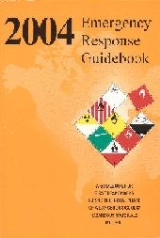
Emergency Response Guidebook
Encyclopedia
The Emergency Response Guidebook is used by first responders, such as firefighter
s, police officer
s, and ambulance
personnel when responding to a transportation emergency involving hazardous materials. It was first issued by the US Department of Transportation
in 1973 and was most recently reissued in 2008 as a joint publication of the Department of Transportation
, Transport Canada, and the Secretariat of Transport and Communications (Mexico). It is issued every 4 years, so the next edition will be published about 2012. It is divided into four color-coded sections and is intended only to be used for the first thirty minutes of an emergency.
) number which is (often) placarded with the other hazardous materials placards. This gives a guide number which refers the user to the orange section.
After this, information for responders on appropriate protective clothing and possible evacuation information for either spill or fire is given. It also includes information on fighting fires (example, do not apply water to sodium
), warnings for spills or leaks, and special directions for first aid (example, not to give mouth-to-mouth resuscitation if the materials are toxic).
Only chemicals that are highlighted in the yellow and blue sections are included in the green section.
.
Firefighter
Firefighters are rescuers extensively trained primarily to put out hazardous fires that threaten civilian populations and property, to rescue people from car incidents, collapsed and burning buildings and other such situations...
s, police officer
Police officer
A police officer is a warranted employee of a police force...
s, and ambulance
Ambulance
An ambulance is a vehicle for transportation of sick or injured people to, from or between places of treatment for an illness or injury, and in some instances will also provide out of hospital medical care to the patient...
personnel when responding to a transportation emergency involving hazardous materials. It was first issued by the US Department of Transportation
United States Department of Transportation
The United States Department of Transportation is a federal Cabinet department of the United States government concerned with transportation. It was established by an act of Congress on October 15, 1966, and began operation on April 1, 1967...
in 1973 and was most recently reissued in 2008 as a joint publication of the Department of Transportation
United States Department of Transportation
The United States Department of Transportation is a federal Cabinet department of the United States government concerned with transportation. It was established by an act of Congress on October 15, 1966, and began operation on April 1, 1967...
, Transport Canada, and the Secretariat of Transport and Communications (Mexico). It is issued every 4 years, so the next edition will be published about 2012. It is divided into four color-coded sections and is intended only to be used for the first thirty minutes of an emergency.
Yellow Section
The first section, with yellow page borders, references the material in order of its assigned 4-digit ID number/UN (United NationsUnited Nations
The United Nations is an international organization whose stated aims are facilitating cooperation in international law, international security, economic development, social progress, human rights, and achievement of world peace...
) number which is (often) placarded with the other hazardous materials placards. This gives a guide number which refers the user to the orange section.
Blue Section
The second section, with blue page borders, references the material in alphabetical order of its name. It then, like the yellow section, gives the guide number (and the UN number) to reference to the orange section. In both the yellow and blue sections, a highlighted entry means an evacuation area needs to be established and the user should first refer to the green section.Orange Section
The third section, with orange page borders, provides safety recommendations and directions on how to proceed during the first thirty minutes. It includes health and fire/explosion hazard information, listing the most dangerous of the two first. For example, "the material gives off irritating vapors, easily ignited by heat, reactive with water," etc.After this, information for responders on appropriate protective clothing and possible evacuation information for either spill or fire is given. It also includes information on fighting fires (example, do not apply water to sodium
Sodium
Sodium is a chemical element with the symbol Na and atomic number 11. It is a soft, silvery-white, highly reactive metal and is a member of the alkali metals; its only stable isotope is 23Na. It is an abundant element that exists in numerous minerals, most commonly as sodium chloride...
), warnings for spills or leaks, and special directions for first aid (example, not to give mouth-to-mouth resuscitation if the materials are toxic).
Green Section
The fourth section, with green page borders, suggests initial evacuation or shelter-in-place distances (protective action distances) for spills of materials that are Toxic by Inhalation (TIH). These distances vary based on the size of the spill and whether the incident has occurred during the day or the night.Only chemicals that are highlighted in the yellow and blue sections are included in the green section.
Weapons of Mass Destruction
Beginning with the 2004 edition, a small section (uncolored) at the back of the book gives information specifically for hazardous materials being used for terrorismTerrorism
Terrorism is the systematic use of terror, especially as a means of coercion. In the international community, however, terrorism has no universally agreed, legally binding, criminal law definition...
.
Unplacarded vehicles
In the event of an unknown material, a special guide (#111) is assigned. If the material is unknown and the UN number is not posted, but a placard is displayed (such as radioactive, or corrosive), special guides are also referenced, as are special guides for certain types of containers.External links
- Downloadable version of book: 2008 Emergency Response Guidebook 2.6 MB PDF file
- Online version of 2004 Emergency Response Guidebook Information

